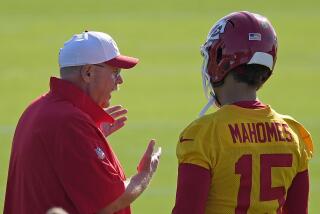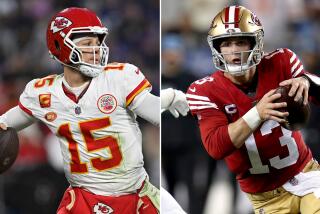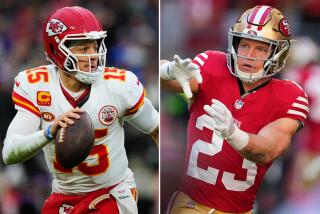AFC Championship : Is Blitz a Ticket to the Super Bowl?
MIAMI — Some of pro football’s offensive and defensive coordinators are saying they’ll pay more attention to the conference finals Sunday than any other playoff games of the Super Bowl era.
Their explanation is that the National Football League’s new blitzing defenses started a revolution this season. And no one knows where it will all end.
These are the questions that keep coming up:
--Are the blitzers about to take over the league?
--Is it possible for a team with an ordinary offense to blitz its way to the Super Bowl?
--Can San Francisco’s Joe Montana and Miami’s Dan Marino throw their passes quickly enough to hold off the aggressive Chicago and Pittsburgh defenses?
“Football became blitzball this season,” Dick Steinberg, director of personnel for the New England Patriots, said the other day. “The league’s fastest rising teams (including Chicago and Pittsburgh) aren’t necessarily the best new teams, but they blitz the best. They have learned how to hurry the quarterbacks and running backs behind the (scrimmage) line before they can get the (offensive) play under way.”
It has long been supposed that Marino and Montana are uncommonly hard to rush. But maybe not. They haven’t faced either of these defenses since Chicago and Pittsburgh mastered their complex blitzing schemes during the final weeks of the 1984 season.
“The blitz is football’s new neutralizer,” Steinberg said. “And it’s the whole story of both these games coming up. The 49ers and Dolphins are both much better than the teams they’re playing. The Bears and Steelers don’t have a chance if they can’t get to the quarterback. The only reason these teams are still alive (in the playoffs) is that they know how to blitz the guy.”
Football people say the biggest change in the recent history of their sport is the widespread development of so many complex new blitzing patterns.
“Since the NFL legalized offensive holding it’s the only way you can pressure the quarterback,” Dallas defensive coordinator Ernie Stautner said. “That’s why you’re seeing more and more of it.”
Defining a blitz as a rush toward the quarterback or a runner in the backfield by any defensive back or linebacker, Stautner said:
“The Steelers will hit Marino with eight or 10 kinds of blitzing patterns. They might rush both outside linebackers. Or the inside backers. Or the weak side linebacker combined with the strong safety. Or both corners or both safeties or everybody. Everybody, I mean, except the guys designated to cover the wide receivers man-for-man. The Bears do all this and more.”
The Steelers have a chance against Miami because they match up well with the Dolphins, Stautner believes.
“The two things you need to beat Miami,” he said, “ are a pass rush and two cornerbacks who can cover their receivers man-for-man. The Steelers have the corners (Dwayne Woodruff and Sam Washington) to stay with (Mark Duper and Mark Clayton). And they showed Denver last week that they have the rush.”
With the same prescription--Lester Hayes, Mike Haynes and a rush--the Raiders beat the Dolphins. Then the Steelers beat the Raiders.
Buffalo Coach Kay Stephenson doubts if the Pittsburgh rush will be on time to bother Marino.
“The thing that makes this team (Miami) so tough,” he said, “is that you can never get the big sack.”
The Buffalo coach, who has played Miami four times in two years, thinks the best the Steelers can get Sunday is close.
“(Pittsburgh Coach) Chuck Noll is the success story of the year in pro football,” Stephenson said. “It’s amazing how Noll revamped this team without an established quarterback. But Miami has the Orange Bowl, it has the weapons, and it has (Coach) Don Shula.”
Hoping for a lift, Noll has activated Pittsburgh linebacker Jack Lambert for this game after a season in which frustrating toe and foot injuries have largely confined the 32-year-old veteran to the bench.
“We’ll use him for sure in some of our prevent-type defenses,” the Pittsburgh coach said.
Noll wanted Lambert on the AFC title game roster as an inspiration for his younger players, although, almost certainly, he’s rusty and still unwell.
“When Jack came back last week,” Noll said, “we put him on the scout team and he knocked the hell out of our offense. He loves football, likes contact and will help us.”
Pittsburgh quarterback Mark Malone, who spent the better part of his first three NFL years injured, wears a knee brace perfected by the Raiders’ trainer, George Anderson, who invented it for Ken Stabler.
“It’s commercially marketed now, anybody can buy it,” said Raider executive Al LoCasale. “The brace is called the Anderson Stablerizer.”
Stabilizing Malone’s bad knee, it gave him the confidence to, among other things, upset the Raiders.
Earlier in his career, Malone, the Steelers’ top choice in the 1980 draft, was one of the NFL’s least-known, top draft choices. Not until this season, which the Steelers began by trading for David Woodley, did they belatedly put Malone in the starting lineup.
Asked why it took a top-drafted quarterback five years to develop in this era, Noll said:
“During Mark’s rookie year, we were short a few people and had to use him as a wide receiver. He got hurt that year and spent two years recuperating. Last season he didn’t play much. This season as soon as he played, he played well, and he’s been getting better and better.”
Miami Coach Don Shula, who passed up a chance to meet the press Friday, agreed to report today. But in the meantime, after drilling his players down the road, Shula defined Marino as a riverboat gambler.
Answering those who think the young quarterback’s foremost quality is stubbornness, Shula said:
“Marino is a winner because he’s not afraid to lose.”
Shula is, among other things, a survivor, having survived the loss of three starters in the last three years--David Overstreet, Rusty Chambers and Larry Gordon--all of them tragically killed.
“Shula can win in spite of everything,” said former Miami defensive back Tim Foley.
Asked how Shula does it, his son David, a Miami assistant coach now, said the old man treats everyone the same.
“Everybody catches hell,” David Shula said.
The result, Memphis writer Al Dunning said one day, is that: “Shula doesn’t exactly coach football. It’s more like he reinvents it every autumn.”
Thus, a decade ago, Shula was the NFL’s greatest exponent of cloud-of-dust football, winning two Super Bowls in which quarterback Bob Griese averaged nine passes a day.
More to Read
Go beyond the scoreboard
Get the latest on L.A.'s teams in the daily Sports Report newsletter.
You may occasionally receive promotional content from the Los Angeles Times.










